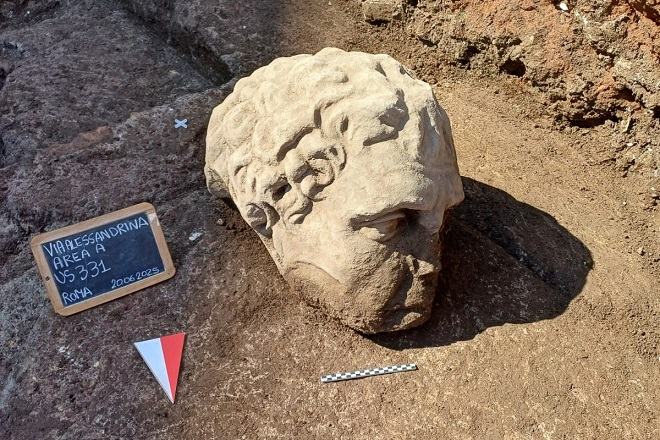

Archaeologists in Rome have uncovered a well-preserved ancient marble head beneath Via Alessandrina, close to Trajan’s Forum, during excavations funded by Italy’s National Recovery and Resilience Plan.
The discovery has sparked strong interest among researchers and officials, as the statue may depict either a Roman emperor or the god Dionysus.
Rome Mayor Roberto Gualtieri announced the find on social media, describing it as “a male face, with thick hair and an intense expression,” hidden beneath the Forum’s square for centuries.
The artifact was found embedded in a layer of medieval brick and lime mortar, indicating it was likely reused as building material long after the fall of the Roman Empire.
Initial observations suggest the sculpture may date to the early second century A.D., possibly during the reign of Emperor Trajan, who ruled from 98 to 117 A.D.
The facial features – wavy hair, high cheekbones, and focused expression – strongly resemble known portraits of Trajan. However, not all scholars agree on the statue’s identity.
A similar marble head, uncovered in the same area years ago, bore features associated with Dionysus, the ancient god of wine and revelry. That earlier find has led some experts to consider the possibility that the newly unearthed head may also represent a divine figure rather than an emperor.
The site lies near the Porticus Trisigmentata, a monumental colonnade that once stood at the entrance of Trajan’s Forum. Designed by Apollodorus of Damascus, a prominent architect of the time, the colonnade featured marble columns more than 40 feet tall.
In its original form, the structure housed statues, military trophies, and detailed reliefs, offering a glimpse into the grandeur of Rome’s imperial age.
Archaeologists plan to conduct laboratory analysis to trace the marble’s origin. This testing may also help clarify the sculpture’s historical context. Once restored, the statue will be added to the collection at the Museums of the Imperial Forums, where it will be on public display.
“Rome never ceases to amaze,” Gualtieri said. “Beneath our feet lives a millennia-old story that continues to inspire the world.”
The find adds another piece to the puzzle of ancient Rome’s past, reinforcing the city’s reputation as one of the world’s richest archaeological landscapes. As excavations continue, researchers remain hopeful that more discoveries await beneath the layers of time.
